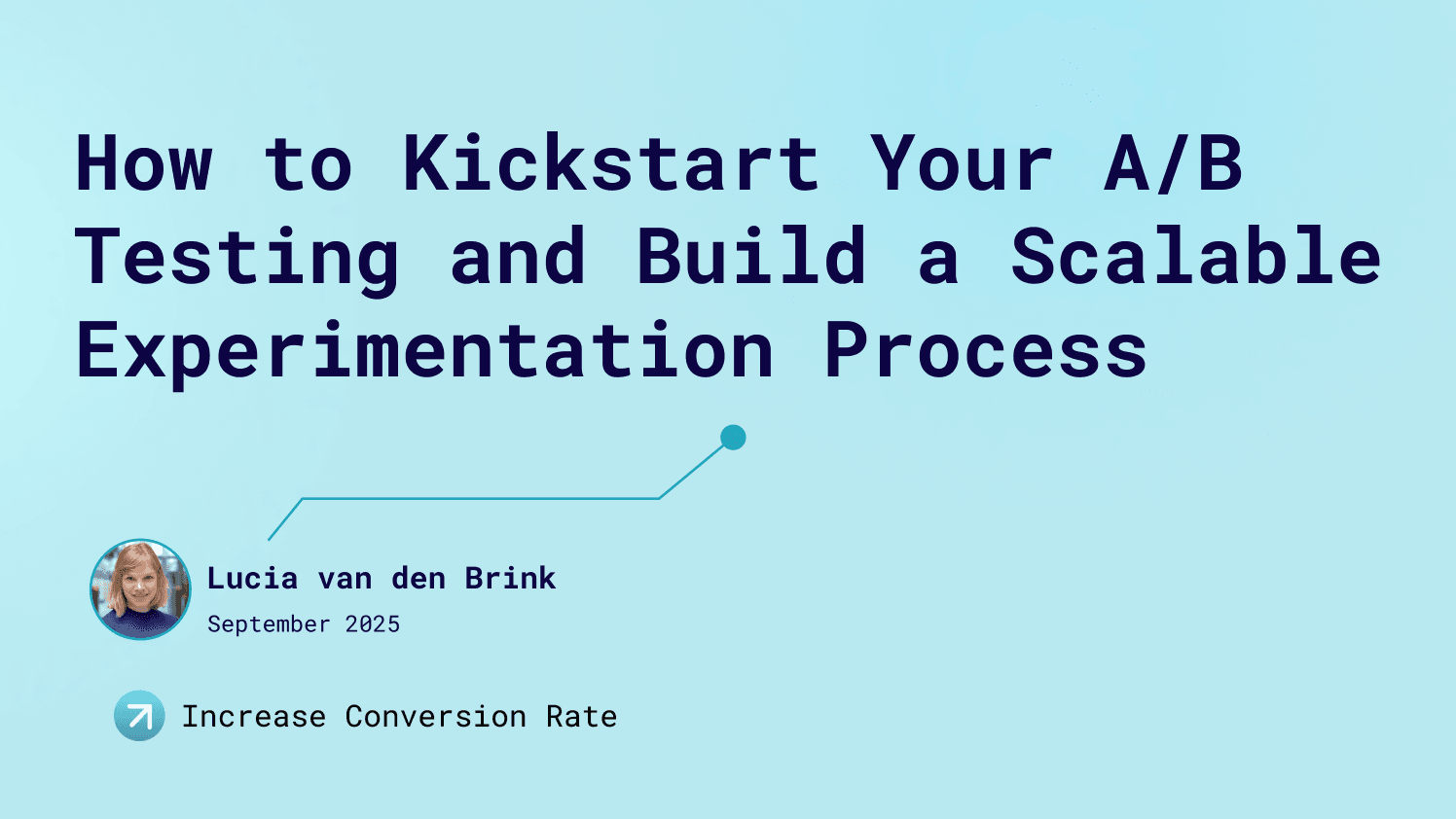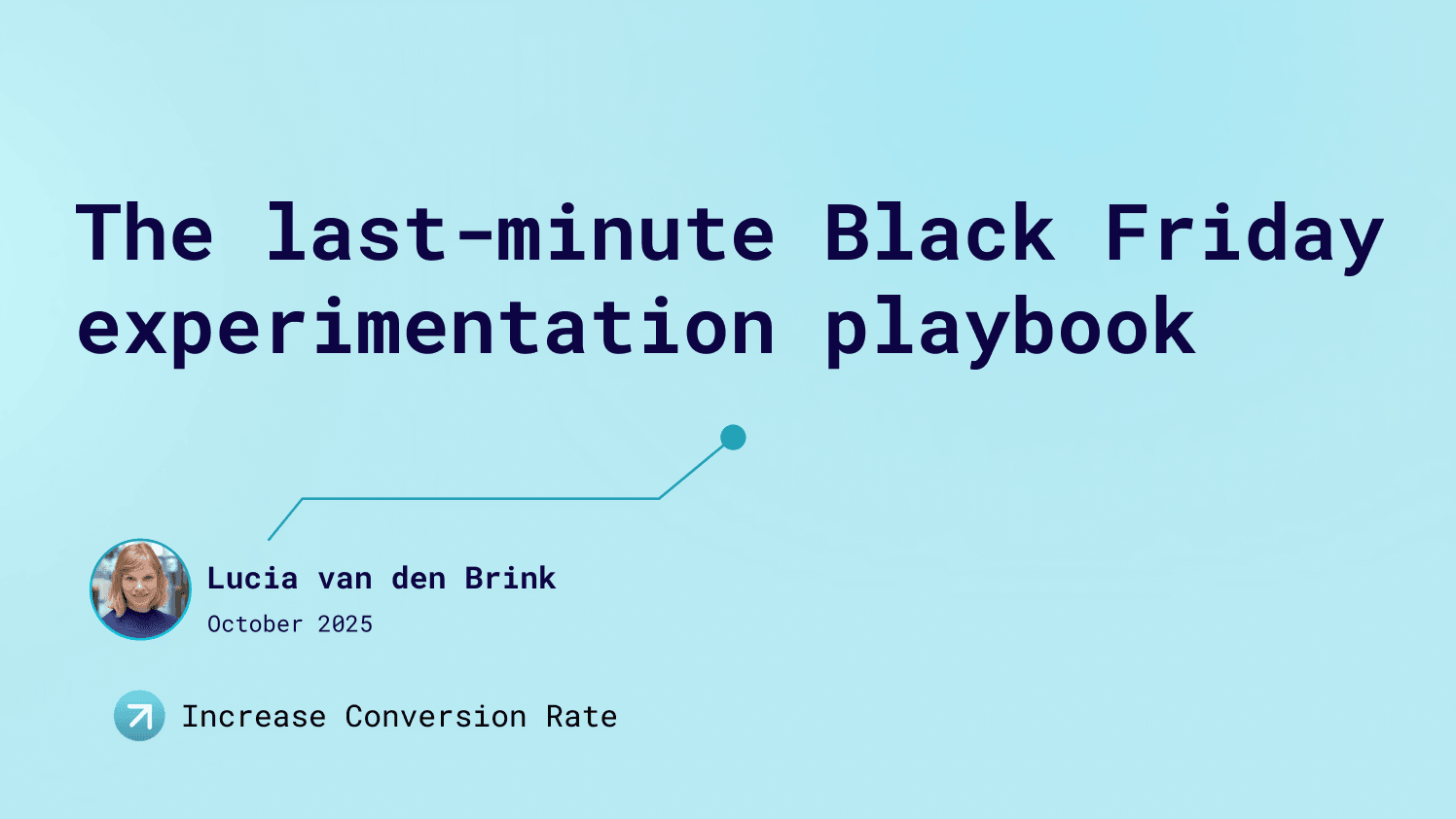
Publication: Oct 31, 2025
The last-minute Black Friday experimentation playbook
When should you have started prepping for Black Friday and Cyber Monday (BFCM)? Before the summer. So if you read this post in October or even November: you’re too late. There. I’ve said it.
But, I’m here to help. Not to scold you. There’s still a lot of quick, and interesting things that we can set up in the next few days and weeks that can have a massive impact. We may be late, but we’re never too late to try.
Like video better? Here’s the YouTube version.
Check out this Notion file — I’ve added a few A/B test ideas for BFCM you might find useful.
Black Friday: yes or no?
The first strategic choice is whether or not to participate in the deep discount game. We generally see two strategic camps:
- Go all in: rely on heavy, striking discounts, volume, and manufactured urgency to drive massive short-term sales. This is the traditional path for most e-commerce players.
- Opt out completely: focus instead on positioning differently. Brands centered on luxury, sustainability, or craftsmanship often skip the deep discounts to preserve brand equity and focus on value proposition rather than price competition. (and this is probably not you, otherwise you wouldn’t be here). Sometimes they do participate, but rebrand to something like ‘Green’ or ‘SLOW’ sales.
The BFCM user behavior shift
The most important realization for any CRO professional is that during BFCM, your users are fundamentally different. Their intent is higher, but their patience is lower. Their psychology is primed for speed and deals.
Key behavioral changes:
- Holding off to buy: In the weeks leading up to BFCM, people actively delay purchases, waiting for the sale to drop.
- Elevated scarcity & urgency sensitivity: Users are "hunting." They are primed for deals, speed, and urgency signals.
- Lower brand loyalty: Users are deal-hopping. Your competitor’s similar product with a better discount is only one click away.
- Faster decisions: Research and buy cycles are shorter. If your site slows them down, they will bounce. And if you have ways to convince them faster, they might work better.
In sum: User behavior is DIFFERENT during BFCM. Therefore, every winning A/B test run during the holidays should be retested outside the seasonal window. Some things only work when people are primed for deals.
Your last-minute experimentation plan
Based on the shifts above, here are targeted, quick experiments you can launch this week:
1. Addressing 'Holding off' Behavior (Pre-BFCM)
If users are waiting, facilitate their wait and capture that demand:
- Waitlists & notifications: Set up simple browser push notifications or email sign-ups specifically for BFCM deals, reminding users when their favorite products drop in price.
Think messages like:
“Stay tuned — 70% off coming tomorrow.”
“It’s here! Savings store-wide TODAY.”
“Last chance — sale ends at midnight!”
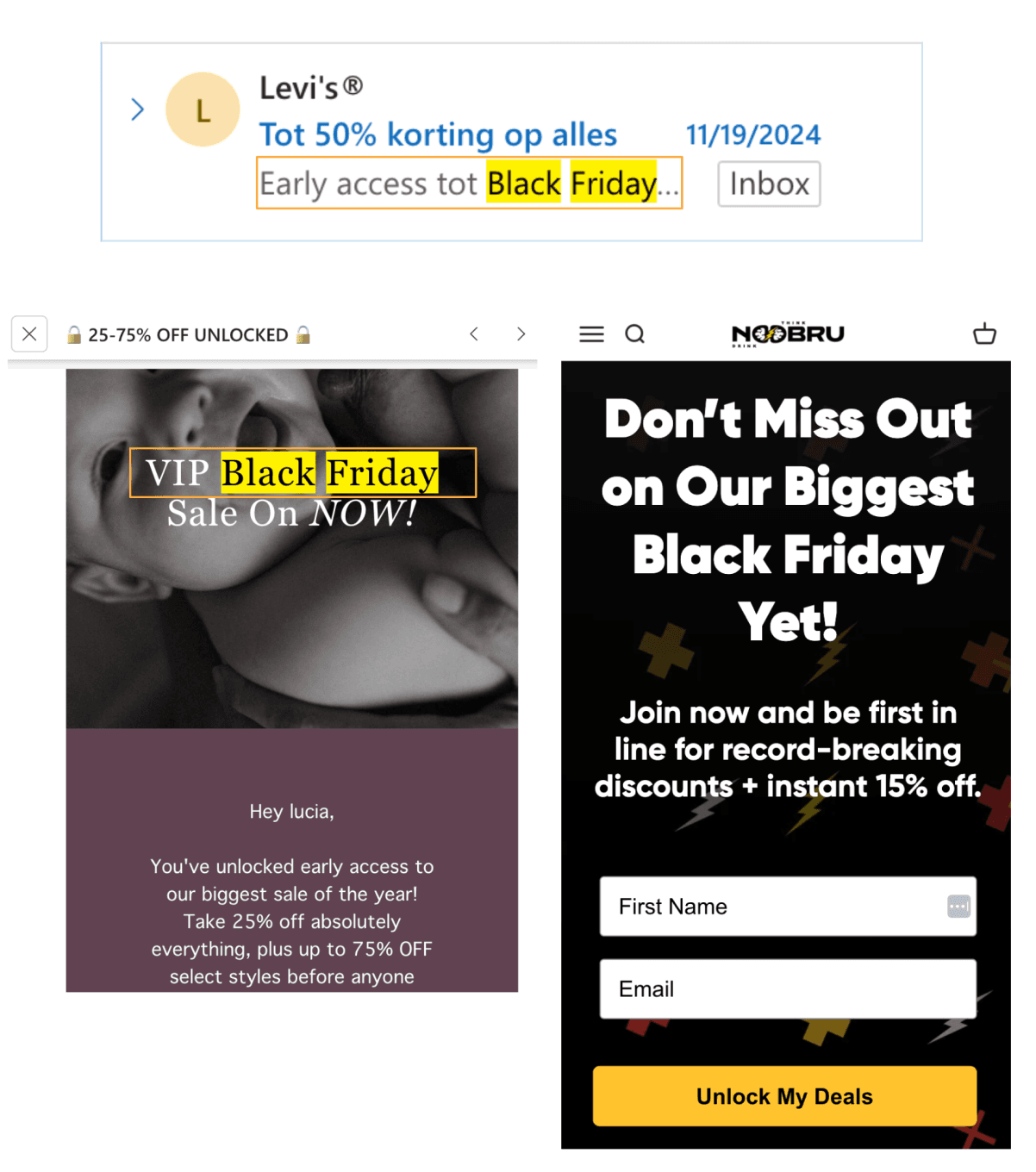
- Cart abandonment urgency: Test adding a clear holiday expiry to abandoned cart notifications: Black Friday is only xx hours long. Are you sure you want to leave your cart unattended?
2. Leveraging scarcity & urgency sensitivity
Move beyond generic countdowns and focus on meaningful deadlines:
- Shipping deadlines: The most meaningful urgency driver: Order before 10pm Friday to get it before Christmas.
- Honest scarcity: Use notifications like "Last 5 items," but only if they are genuinely true and tied to real inventory levels.

- Cart reservation: Experiment with storing items in the shopping cart for a limited time (e.g., 15 minutes max), similar to major flash sale sites like Asos or Zalando Lounge.

3. Optimizing discounts and pricing display
- Visual impact: Test making discounts bigger and more striking. Highlight the percentage discount prominently.

- Absolute value anchoring: For certain price points, test displaying the absolute value saved (e.g., "$100 Saved") instead of just the percentage, as the larger number can be more visually impactful.

- Saved amount in cart: Ensure the total amount "saved" is clearly displayed in the cart and checkout process.
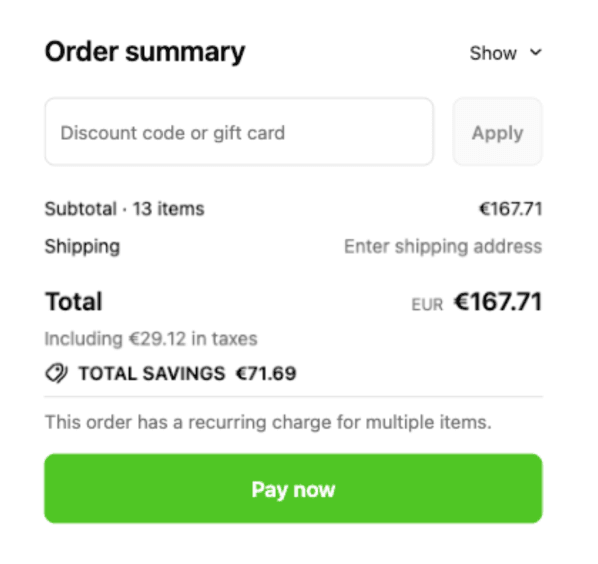
High vs. Low Ticket: Be aware that highly aggressive discount displays that work well for lower-priced items might have the reverse effect (damaging trust) for high-ticket or luxury products.
4. Countering Lower Brand Loyalty (Focus on USPs)
Since users are hunting for the best deal, you must quickly justify why they should buy your deal over the competitor’s. Here’s how:
- Highlight USPs: Ensure your Unique Selling Propositions (USPs) are crystal clear on product pages and in the header/footer.

- Run a quick survey: If you don't know your strongest USPs, launch a quick pop-up survey asking existing customers what made them choose you on your thank you-page. Use these qualitative results to inform messaging instantly.
5. Facilitating Faster Decisions
- Reviews: Can you leverage social proof more aggressively? Test moving review stars or summary stats higher up the product page, closer to the 'Add to Cart' button.
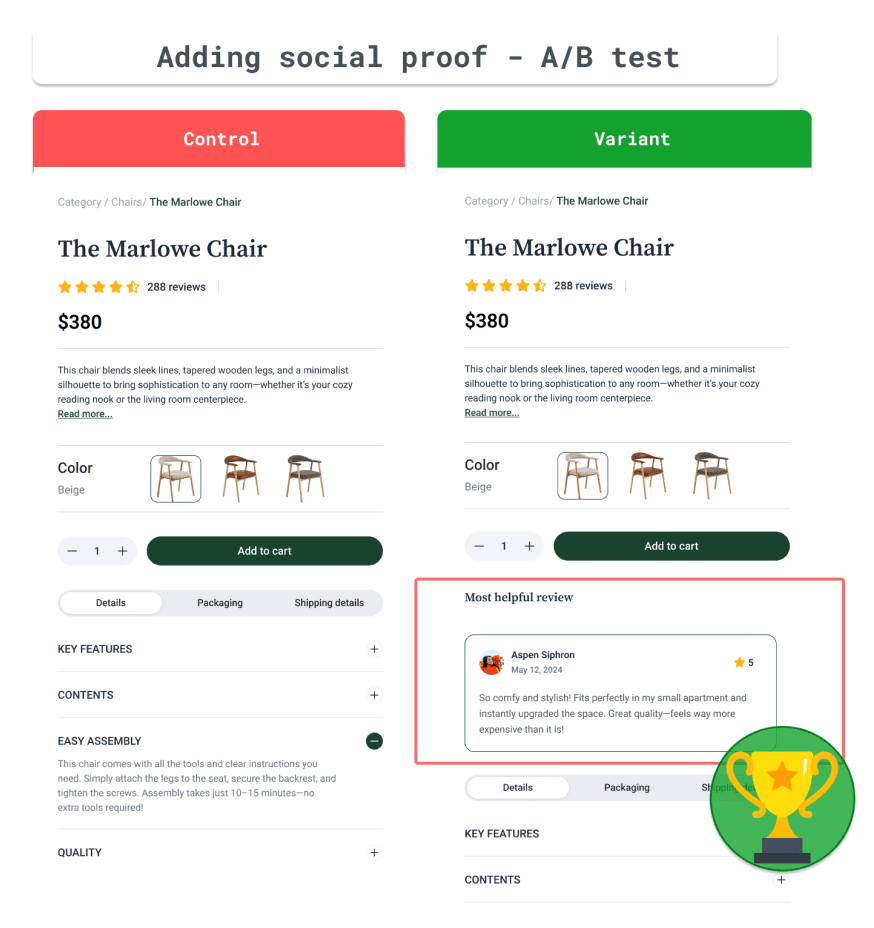
- Returns Policy clarity: Focus intensely on free returns and how the return process works. But be sure to measure Returns: Optimize conversion, but always measure returns post-BFCM. If you boost conversion but spike returns, you don’t have a real win.

- Customer Service visibility: Test displaying Customer Service options prominently. While some teams fear an influx of calls, the boost in conversion gained from reducing purchase anxiety is usually worth the operational cost.

What NOT to Do: Crossing the Line
⚠️ Do Not Cross the Line ⚠️
Black Friday is the moment where CRO teams are most tempted to over-prioritize conversion at the expense of … well: everything. Fake scarcity, misleading timers, and hidden fees (Dark Patterns) are not only unethical but damage long-term customer value. This is often the single biggest mistake.
To ensure you maintain ethical standards while testing, run every experiment through these three checks:
- The 'Mom' test: Ask yourself: Would your mother (or any other loved one) approve of this tactic? If you feel ashamed or bad, don't do it.
- The front-page test: How would you feel if what you are testing showed up tomorrow on the front pages of the national newspaper? If you wouldn't like this to show up in the news, don't do it.
- The regret test: If a user feels regret after taking an action (like making a purchase), it could indicate the action was manipulative rather than a helpful nudge. While hard to measure, look at churn and post-purchase surveys.
Other Strategic Mistakes to Avoid:
- Large redesigns: There is no time for big-bang changes. Stick to smaller, targeted experiments. You won't get clean learning from a full-site redesign during a period of such extreme behavioral change.
- Treating BF wins as evergreen: Remember the golden rule: A win in November is a Black Friday win, not an evergreen one. Aggressive urgency banners that lift conversions now can actively hurt them in January when shoppers aren't hunting for deals.
Experimentation program systems
Since you are rushing, focus on leveraging your existing infrastructure to maximize output:
RESEARCH: Focus research efforts on immediate, high-impact areas. Can you run quick exit-intent surveys or analyze session recordings during BFCM? And can you still learn from last year’s?

PLANNING: Use last year's data to estimate how much more traffic you can expect. Based on this, adjust your testing runtime and MDE expectations. Can you afford to shorten test runtimes slightly due to the massive influx of volume? Can you even run any A/B test at all, or should you move toward Multiple Armed Bandits?

PRIORITIZATION: Focus on experiments targeting the high-intent shopper psychology (scarcity, pricing, USPs). Leave long-term structural tests for Q1.

Beyond Black Friday
Your work doesn't end on Cyber Monday. To ensure your "last-minute" effort pays off next year:
- Retest "winners" in January: Seasonal bias is real. Immediately queue up your most successful BFCM experiments to re-run in a non-peak, non-sale month.
- Bundle learnings: If you only do one thing: analyze BFCM traffic in depth. Create a comprehensive analysis packet of all information, learnings, and hypothesis results for the next team to start with in the summer.
I hope this gave you the inspiration and the ethical checks you need to launch some powerful experiments immediately that can still make a change.
Go forth and test! 🚀
